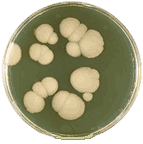Papers in the Biological Sciences
Date of this Version
2012
Document Type
Article
Citation
Journal of Applied Microbiology 113, pp. 126–134. doi:10.1111/j.1365-2672.2012.05317.x
Abstract
Aims: For Ophiostoma (Ceratocystis) ulmi, the ability to undergo morphological change is a crucial factor for its virulence. To gain an understanding of quorum- sensing activity in O. ulmi as it relates to yeast-mycelium dimorphism control, this study examines the effects of branched-chain amino acids as well as their fusel alcohols and fusel acids as quorum sensing molecules.
Methods and Results: In a defined medium containing glucose, proline and salts, O. ulmi grew as yeasts when the culture was inoculated with a high density of spores (2-107 CFU ml-1) and as mycelia when inoculated with a low spore density (4-105 CFU ml-1). The cultures displaying yeast morphology secreted a quorum-sensing factor that shifted the morphology from mycelia to yeast. This quorum-sensing molecule was lipophilic and extractable by organic solvents from the spent medium. Using GC⁄MS analysis, it was determined that the major compound in the extract was 2-methyl-1-butanol. A similar effect was observed when the branched-chain amino acids (fusel alcohol precursors) were used as the nitrogen source. E, E-farnesol had no effect on the morphology of O. ulmi.
Conclusions: Addition of the branched-chain amino acids or one of the compounds detected in the spent medium, 2-methyl-1-butanol or 4-hydroxyphenylacetic acid, or methylvaleric acid, decreased germ tube formation by more than 50%, thus demonstrating a quorum sensing molecule behavior in O. ulmi cultures.
Significance and impact of the study: This study presents advances in the investigation of dimorphism in O. ulmi, complementing the existing scientific basis, for studying, understanding and controlling this phenomenon.
Included in
Environmental Microbiology and Microbial Ecology Commons, Other Life Sciences Commons, Pathogenic Microbiology Commons


Comments
Copyright 2012 The Society for Applied Microbiology. Used by permission.